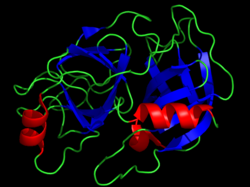| Serine protease | |||||||||
|---|---|---|---|---|---|---|---|---|---|
 Crystal structure of bovine chymotrypsin. The catalytic residues are shown as yellow sticks. Rendered from PDB 1CBW. | |||||||||
| Identifiers | |||||||||
| EC no. | 3.4.21.- | ||||||||
| Databases | |||||||||
| IntEnz | IntEnz view | ||||||||
| BRENDA | BRENDA entry | ||||||||
| ExPASy | NiceZyme view | ||||||||
| KEGG | KEGG entry | ||||||||
| MetaCyc | metabolic pathway | ||||||||
| PRIAM | profile | ||||||||
| PDB structures | RCSB PDB PDBe PDBsum | ||||||||
| |||||||||

Serine proteases (or serine endopeptidases) are enzymes that cleave peptide bonds in proteins. Serine serves as the nucleophilic amino acid at the (enzyme's) active site.[1] They are found ubiquitously in both eukaryotes and prokaryotes. Serine proteases fall into two broad categories based on their structure: chymotrypsin-like (trypsin-like) or subtilisin-like.[2]
- ^ Hedstrom L (December 2002). "Serine protease mechanism and specificity". Chemical Reviews. 102 (12): 4501–4524. doi:10.1021/cr000033x. PMID 12475199.
- ^ Madala PK, Tyndall JD, Nall T, Fairlie DP (June 2010). "Update 1 of: Proteases universally recognize beta strands in their active sites". Chemical Reviews. 110 (6): PR1–P31. doi:10.1021/cr900368a. PMID 20377171.